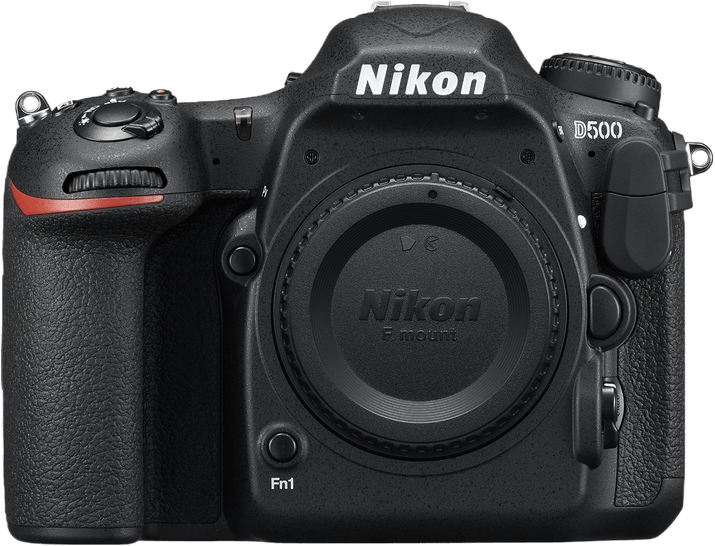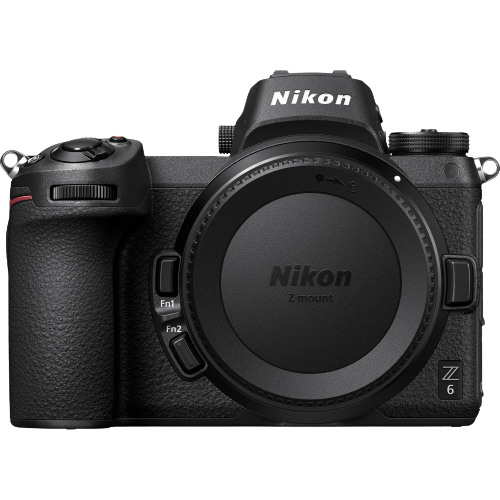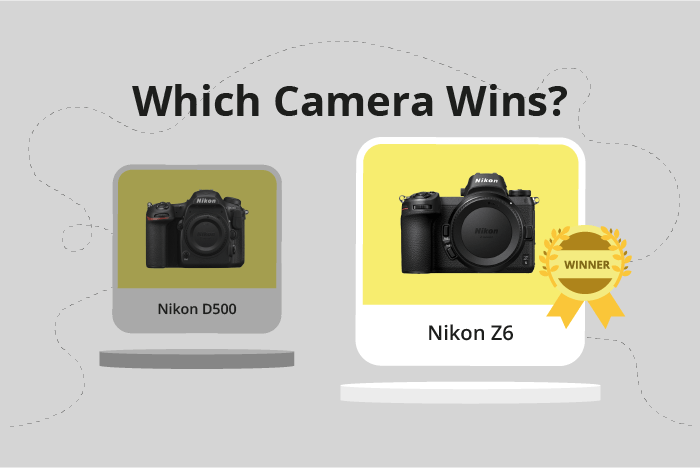Nikon D500 vs Z6 Comparison
Nikon D500

Nikon Z6

The Nikon Z6 takes the lead with a score of 81/100, while the Nikon D500 follows closely at 75/100. Both cameras share similarities, such as their launch price of $2000 and announcement years in the mid-2010s. However, the Z6, a mirrorless camera, surpasses the D500, a DSLR, in terms of size and weight. The Z6 measures 134 x 101 x 68mm and weighs 675g, making it more compact and lighter than the D500, which measures 147 x 115 x 81mm and weighs 860g.
On the other hand, the D500 still has its merits, offering a sturdier build and a more traditional DSLR experience. When comparing these two cameras, it’s essential to consider personal preferences and desired usage. The Nikon Z6’s lighter and more compact design makes it an excellent choice for photographers who value portability, while the Nikon D500’s traditional DSLR build may appeal to those who prefer a more classic design.
Nikon D500 vs Z6 Overview and Optics
The Nikon Z6 outperforms the Nikon D500 in optics with a score of 83/100 compared to the D500’s score of 69/100. Both cameras have certain specifications in common, such as a CMOS sensor type and a shooting speed above 10 frames per second. However, there are notable differences that set the Z6 apart.
The Nikon Z6 boasts a higher megapixel count of 24.5, compared to the D500’s 20.9, providing more detail and resolution in images. Additionally, the Z6 has a faster processor, the Expeed 6, which contributes to faster image processing and overall performance. The Z6 also has a higher DXOMARK score for its sensor at 95, as opposed to the D500’s 84, reflecting superior image quality. Furthermore, the Z6 has a full-frame sensor size, allowing for better low light performance and a shallower depth of field. The Z6 also benefits from in-built image stabilization and a Nikon Z lens mount, which offers compatibility with a new range of high-quality lenses.
On the other hand, the D500 has a Nikon F DX lens mount, which is compatible with a wide range of existing Nikon lenses, making it more versatile for photographers with an existing collection of lenses. However, this advantage is not enough to outweigh the Z6’s superior specifications.
The Nikon Z6 clearly offers better optics, with a higher megapixel count, faster processor, and improved sensor performance. Its full-frame sensor and image stabilization further enhance its capabilities. While the D500 does have the advantage of compatibility with a larger range of lenses, the Z6’s overall superiority in optics makes it the better choice for photographers seeking top-notch image quality.
Nikon D500 vs Z6 Video Performance
When comparing the video capabilities of the Nikon D500 and the Nikon Z6, the Nikon Z6 emerges as the winner with a video score of 83/100, while the Nikon D500 has a score of 70/100. The difference in scores is 13 points. Both cameras share some common specifications, such as having a maximum video resolution of 4K and maximum video dimensions of 3840 x 2160. Additionally, both cameras have built-in time-lapse functionality.
The Nikon Z6 surpasses the D500 in terms of video performance, mainly due to its higher maximum video frame rate of 60fps, as opposed to the 30fps offered by the D500. This means that the Z6 can capture smoother and more detailed video footage, especially in fast-paced situations or when recording slow-motion footage.
On the other hand, the Nikon D500 does not have any distinct advantages over the Z6 in terms of video capabilities. Both cameras share the same maximum video resolution and dimensions, as well as time-lapse functionality. The only difference between the two cameras is the frame rate, and the Z6 clearly outperforms the D500 in this aspect.
Taking these factors into consideration, it is evident that the Nikon Z6 is the superior choice for video recording when compared to the Nikon D500. The higher frame rate of the Z6 allows for smoother and more detailed footage, which is crucial for capturing high-quality video. The D500, while still a capable camera, falls short in this regard and does not offer any additional advantages over the Z6. Therefore, the Nikon Z6 is the recommended choice for those prioritizing video capabilities in their camera selection.
Nikon D500 vs Z6 Features and Benefits
The Nikon D500 and Nikon Z6 both have a feature score of 87/100, indicating that they are equal in terms of overall features. Both cameras have a 3.2-inch touchscreen, WIFI, and Bluetooth capabilities, making them similar in terms of user interface and connectivity options.
The Nikon D500 has a higher screen resolution, with 2,359,000 dots compared to the Nikon Z6’s 2,100,000 dots. This results in a sharper and clearer image display on the D500’s screen. Additionally, the D500 has a flip screen, allowing for greater flexibility when shooting from different angles or capturing self-portraits.
On the other hand, the Nikon Z6 does not have a flip screen, which may limit its versatility in certain shooting situations. However, both cameras lack GPS functionality, which could be a disadvantage for users who need to geotag their images for location-based purposes.
In terms of features, both the Nikon D500 and Nikon Z6 are strong contenders, with the D500 having a slight advantage due to its higher screen resolution and flip screen. The Z6, though lacking a flip screen, still offers a solid set of features that make it a worthy competitor. Users should consider their specific needs and preferences when choosing between these two cameras, as both offer high-quality performance and functionality.
Nikon D500 vs Z6 Storage and Battery
The Nikon D500 outperforms the Nikon Z6 in storage and battery with a score of 79/100 compared to the Z6’s 35/100. Both cameras use the EN-EL15 battery type, but the D500 has a significantly longer battery life of 1240 shots, while the Z6 only manages 310 shots. Additionally, the D500 provides more versatility in storage options, offering two memory card slots and compatibility with SD, SDHC, SDXC (UHS-II compatible), and XQD cards. The Z6, on the other hand, has only one memory card slot and accepts only XQD cards.
The D500’s superior battery life and storage options make it the clear winner in this category. However, the Z6 does offer USB charging, a feature not available on the D500. This could be an advantage for some users who prefer the convenience of charging their camera via USB.
Taking these factors into account, the Nikon D500 clearly excels in storage and battery performance, making it a better choice for users who prioritize these features. The Nikon Z6, while offering USB charging, falls short in comparison due to its limited storage options and shorter battery life.
Nikon D500 vs Z6 – Our Verdict
Are you still undecided about which camera is right for you? Have a look at these popular comparisons that feature the Nikon D500 or the Nikon Z6:

